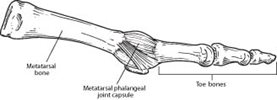Capsulitis of the Second Toe
What Is Capsulitis of the Second Toe?
Capsulitis of the second toe occurs in the ligaments surrounding the joint at the base of the second toe. These ligaments form a capsule, which helps the joint to function properly. Capsulitis is a condition in which these ligaments have become inflamed. Although capsulitis can also occur in the joints of the third or fourth toes, it most commonly affects the second toe. This inflammation causes considerable discomfort and, if left untreated, can eventually lead to a weakening of surrounding ligaments that can cause dislocation of the toe. Capsulitis—also referred to as predislocation syndrome—is a common condition that can occur at any age.
Causes of Capsulitis of the Second Toe
It is generally believed that capsulitis of the second toe is a result of abnormal foot mechanics, where the ball of the foot beneath the toe joint takes an excessive amount of weightbearing pressure.
Certain conditions or characteristics can make a person prone to experiencing excessive pressure on the ball of the foot. These most commonly include a severe bunion deformity, a second toe longer than the big toe, an arch that is structurally unstable and a tight calf muscle.
Symptoms of Capsulitis of the Second Toe
Because capsulitis of the second toe is a progressive disorder and usually worsens if left untreated, early recognition and treatment are important. In the earlier stages—the best time to seek treatment—the symptoms may include:
- Pain, particularly on the ball of the foot. It can feel like there’s a marble in the shoe or a sock is bunched up
- Swelling in the area of pain, including the base of the toe
- Difficulty wearing shoes
- Pain when walking barefoot
In more advanced stages, the supportive ligaments weaken, leading to failure of the joint to stabilize the toe. The unstable toe drifts toward the big toe and eventually crosses over and lies on top of the big toe—resulting in crossover toe, the end stage of capsulitis. The symptoms of crossover toe are the same as those experienced during the earlier stages. Although the crossing over of the toe usually occurs over a period of time, it can appear more quickly if caused by injury or overuse.
Diagnosis of Capsulitis of the Second Toe
An accurate diagnosis is essential because the symptoms of capsulitis can be similar to those of a condition called Morton’s neuroma, which is treated differently from capsulitis. In arriving at a diagnosis, the foot and ankle surgeon will examine the foot, press on it and maneuver it to reproduce the symptoms. The surgeon will also look for potential causes and test the stability of the joint. X-rays are usually ordered, and other imaging studies are sometimes needed.
Nonsurgical Treatment
The best time to treat capsulitis of the second toe is during the early stages, before the toe starts to drift toward the big toe. At that time, nonsurgical approaches can be used to stabilize the joint, reduce the symptoms and address the underlying cause of the condition.
The foot and ankle surgeon may select one or more of the following options for early treatment of capsulitis:
- Rest and ice. Staying off the foot and applying ice packs help reduce the swelling and pain. Apply an ice pack, placing a thin towel between the ice and the skin. Use ice for 20 minutes and then wait at least 40 minutes before icing again.
- Oral medications. Nonsteroidal anti-inflammatory drugs (NSAIDs), such as ibuprofen, may help relieve the pain and inflammation.
- Taping/splinting. It may be necessary to tape the toe so that it will stay in the correct position. This helps relieve the pain and prevent further drifting of the toe.
- Stretching. Stretching exercises may be prescribed for patients who have tight calf muscles.
- Shoe modifications. Supportive shoes with stiff soles are recommended because they control the motion and lessen the amount of pressure on the ball of the foot.
- Orthotic devices. Custom shoe inserts are often very beneficial. These include arch supports or a metatarsal pad that distributes the weight away from the joint.
When Is Surgery Needed?
Once the second toe starts moving toward the big toe, it will never go back to its normal position unless surgery is performed. The foot and ankle surgeon will select the procedure or combination of procedures best suited to the individual patient.
Why choose a foot and ankle surgeon?
Foot and ankle surgeons are the leading experts in foot and ankle care today. As doctors of podiatric medicine – also known as podiatrists, DPMs or occasionally “foot and ankle doctors” – they are the board-certified surgical specialists of the podiatric profession. Foot and ankle surgeons have more education and training specific to the foot and ankle than any other healthcare provider.
Foot and ankle surgeons treat all conditions affecting the foot and ankle, from the simple to the complex, in patients of all ages including capsulitis of the second toe. Their intensive education and training qualify foot and ankle surgeons to perform a wide range of surgeries, including any surgery that may be indicated for capsulitis of the second toe.